Training your abs is a important part of strengthening and sculpting your stomach. Whether you are a gym rat or devising your first training plan, the workouts below will help you meet your fitness goals.
vertical leg raise (on parallel bars)
_Hips_360.gif)
1. Position yourself on the parallel bars by gripping each bar with your hands. Your palms should be facing inward.
2. Lift your body off the ground by straightening your arms. Your body should be hanging in the air, with your legs hanging straight down.
3. Keep your legs together and your knees straight. Engage your core muscles to prepare for the leg raise.
4. Slowly raise your legs upward while keeping them straight. Try to bring them up to a 90-degree angle, or as high as you can comfortably go. Ensure that you're not using momentum to swing your legs up, but rather using your abdominal muscles to lift them.
5. Hold the position for a second or two at the top of the movement to maximize the contraction in your abs.
6. Slowly lower your legs back down to the starting position. This should be done in a controlled manner to maintain the tension in your abs.
7. Repeat the movement for your desired number of repetitions.
Remember to breathe throughout the exercise. Inhale as you lower your legs and exhale as you raise them. This exercise can be challenging, so start with a few repetitions and gradually increase as your strength improves.
v-sit on floor
1. Start by finding a comfortable spot on the floor where you have enough space to extend your legs and arms.
2. Sit down on the floor with your legs extended in front of you.
3. Lean back slightly, keeping your back straight and not rounded. Engage your core muscles to maintain this position.
4. Bend your knees and lift your feet off the floor. Your thighs and torso should form a V shape, hence the name of the exercise.
5. Extend your arms straight out in front of you, parallel to the floor. This will help you balance.
6. Hold this position for as long as you can, aiming for at least 30 seconds to start. Remember to breathe normally throughout the exercise.
7. Lower your legs and relax your arms to return to the starting position.
8. Repeat the exercise for the desired number of repetitions or for a set amount of time.
Remember, the key to this exercise is to keep your abs engaged and your back straight. If you're having trouble maintaining the V shape, you can modify the exercise by keeping your feet on the floor.
twisted leg raise (female)
_Waist_360.gif)
1. Start by lying flat on your back on a comfortable, flat surface. Extend your legs fully and place your arms at your sides.
2. Lift your legs off the ground, keeping them straight and together. Your body should form a 90-degree angle.
3. Now, twist your hips to the right, lowering your legs towards the ground. Make sure to keep your legs straight and together.
4. Just before your legs touch the ground, pause for a moment, then lift them back up to the center.
5. Repeat the same movement, but this time twist your hips to the left.
6. Continue alternating sides for each rep.
7. Aim for 3 sets of 10-15 reps, or as many as you can manage with good form.
Remember to engage your abs throughout the exercise, and not to let your lower back lift off the ground. This exercise should be done in a slow and controlled manner to maximize its effectiveness.
twisted leg raise
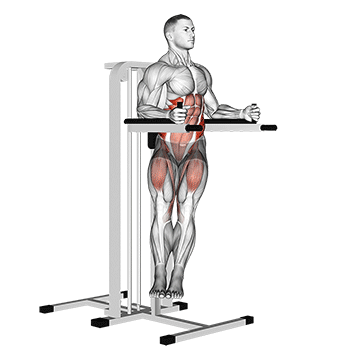
1. Start by lying flat on your back on a comfortable, flat surface. Extend your legs fully and place your arms at your sides.
2. Lift your legs off the ground until they're at a 90-degree angle with your torso. Keep your legs straight and together.
3. Engage your abs and twist your hips to the right, lowering your legs towards the ground. Ensure you do this movement slowly and controlled, without letting your legs touch the ground.
4. Lift your legs back to the center, still keeping them straight and together.
5. Repeat the twist on your left side. This completes one rep.
6. Aim to do 3 sets of 10-15 reps each, depending on your fitness level. Remember to keep your movements slow and controlled, and your abs engaged throughout the exercise.
Remember, this exercise should be challenging but not painful. If you feel any discomfort or pain, stop the exercise immediately and consult with a fitness professional.
tuck crunch
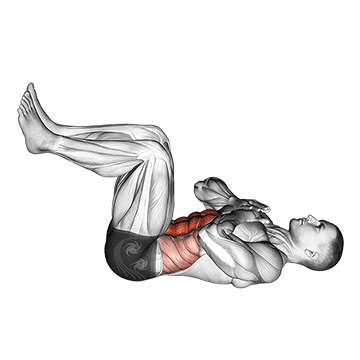
To perform the tuck crunch, start by sitting on the floor with your knees bent and feet flat on the ground. Lean back slightly to engage your abs, keeping your back straight. This is your starting position.
Next, lift your feet off the ground and tuck your knees towards your chest while simultaneously moving your upper body forward. Your elbows should be pointing outwards and your hands should be reaching towards your ankles.
Ensure that your abs are engaged throughout the movement. Squeeze your abs at the top of the movement for a second, then slowly lower your body back to the starting position.
Remember to breathe in as you lower your body and breathe out as you perform the crunch.
Repeat this movement for the desired number of repetitions.
Ensure to keep your movements controlled, don't rush through the exercise. The slower you go, the more your abs have to work.
This exercise can be modified to be easier by keeping your feet on the ground and simply leaning forward to meet your knees. To make it more challenging, try extending your legs straight out in front of you instead of tucking them in.
Remember, it's important to keep your back straight and not to strain your neck during this exercise. If you feel any discomfort or pain, stop the exercise immediately.
suspended reverse crunch
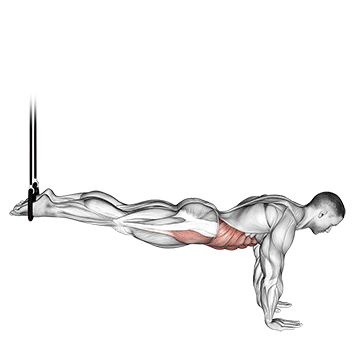
To perform the suspended reverse crunch, start by finding a stable bar that is high enough for you to hang from.
1. Reach up and grasp the bar with both hands, palms facing forward. Your hands should be shoulder-width apart.
2. Hang from the bar, keeping your body straight and your feet off the ground. This is your starting position.
3. Now, engage your abs and lift your knees towards your chest. Try to keep your legs together and your feet pointed.
4. Once your knees are as high as you can get them, pause for a moment and then slowly lower them back down to the starting position.
5. Make sure to keep your abs engaged and your body as still as possible throughout the movement.
6. Repeat this movement for your desired number of reps.
Remember to breathe in as you lower your legs and breathe out as you lift them. This exercise can be challenging, so start with a small number of reps and gradually increase as your strength improves.
suspended abdominal fallout
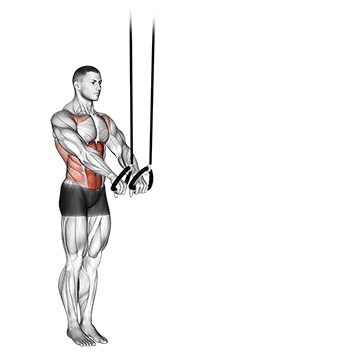
To perform the suspended abdominal fallout exercise, follow these steps:
1. Start by standing upright with your feet shoulder-width apart.
2. Extend your arms in front of you at shoulder height, palms facing down. This is your starting position.
3. Slowly lean forward from your ankles, keeping your body straight from head to heels. As you lean forward, extend your arms out in front of you.
4. Continue to lean forward until you feel a strong contraction in your abs. Make sure to keep your body straight and avoid bending at the hips.
5. Hold this position for a moment, then slowly return to the starting position.
6. Repeat this movement for the desired number of repetitions.
Remember to keep your abs engaged throughout the entire exercise and avoid letting your lower back sag. This exercise can be challenging, so start with a small number of repetitions and gradually increase as your strength improves.
straddle planche
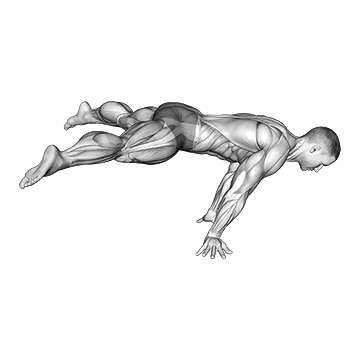
1. Begin by warming up your body with some light cardio exercises like jogging or jumping jacks. This will help to prevent injury during the exercise.
2. Find a clear, open space where you can perform the exercise without any obstructions. You will need enough room to extend your legs out to the sides.
3. Start in a standing position. Bend over and place your hands flat on the ground, shoulder-width apart.
4. Slowly walk your feet back until your body is in a straight line, similar to a push-up position. This is your starting position.
5. Now, lean your weight forward onto your hands while simultaneously lifting your feet off the ground. Your body should be parallel to the ground.
6. Spread your legs apart in a straddle position while keeping them straight. Your body should now resemble a 'T' shape.
7. Hold this position for as long as you can, aiming for at least 10 seconds to start with. Keep your abs engaged and your body as straight as possible.
8. Slowly lower your feet back to the ground and return to the starting position.
9. Repeat the exercise for the desired number of repetitions.
Remember to breathe normally throughout the exercise and to keep your body as straight as possible. This exercise requires a lot of strength and balance, so don't be discouraged if you can't hold the position for very long at first. With regular practice, your strength and endurance will improve.
straddle maltese
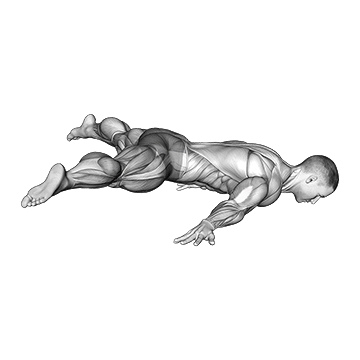
1. Start by finding a clear, open space where you can comfortably spread out your arms and legs. Make sure the floor is not too hard or slippery to prevent injuries.
2. Stand straight with your feet shoulder-width apart. This is your starting position.
3. Slowly lower your body into a squat position, keeping your back straight and your knees over your toes.
4. As you squat, spread your legs apart into a straddle position. Your feet should be wider than your shoulders and pointed outwards.
5. Extend your arms straight out to the sides, parallel to the floor. Your body should resemble the letter 'T'.
6. Hold this position, known as the straddle maltese, for a few seconds. You should feel your abs and core muscles working to maintain balance.
7. Slowly return to the starting position by bringing your legs back together and lowering your arms.
8. Repeat this exercise for a set of 10-15 repetitions. Aim for 3-4 sets in total.
Remember to keep your movements slow and controlled, focusing on engaging your abs throughout the exercise. Breathe in as you lower into the straddle maltese position and breathe out as you return to the starting position.
spine twist

1. Start by sitting tall on the floor with your legs extended in front of you. Your feet should be hip-width apart. If you find it difficult to sit tall, you can sit on a folded blanket or a yoga block.
2. Extend your arms out to the sides at shoulder height, palms facing forward. This is your starting position.
3. Inhale deeply and as you exhale, twist your torso to the right, keeping your spine tall and your hips square. Your arms should follow the movement of your torso.
4. As you twist, pull your abs in towards your spine. This will engage your abdominal muscles and protect your lower back.
5. Hold the twist for a moment, then inhale as you return to the center.
6. Repeat the twist on the left side. This completes one repetition.
7. Aim for 10-15 repetitions, alternating sides each time.
Remember to keep your spine tall throughout the exercise and avoid leaning back or forward. Your abs should be doing the work, not your back or neck. If you feel any discomfort in your back or neck, reduce the intensity of the twist or take a break.
sit-up with arms on chest
1. Start by laying flat on your back on a comfortable, yet firm surface. This could be a yoga mat or a carpeted floor.
2. Bend your knees and plant your feet flat on the ground. Your feet should be hip-width apart.
3. Cross your arms over your chest so that your right hand is touching your left shoulder and your left hand is touching your right shoulder.
4. Engage your abdominal muscles by drawing your belly button in towards your spine. This is your starting position.
5. Slowly lift your upper body towards your knees, keeping your arms crossed over your chest. Your lower back should lift off the floor.
6. Continue lifting your body until your elbows touch your knees or you've reached a comfortable height.
7. Hold this position for a moment, ensuring your abs remain engaged.
8. Slowly lower your body back down to the starting position.
9. Repeat this movement for your desired number of repetitions.
Remember to breathe throughout the exercise. Inhale as you lower your body and exhale as you lift. Keep your movements controlled and avoid using momentum to lift your body. Your abs should be doing the work.
sit-up v. 2
Begin by lying flat on your back on a comfortable, flat surface. Bend your knees and plant your feet firmly on the ground, hip-width apart. Place your hands behind your head, with your elbows pointing outwards. This is your starting position.
Engage your core and lift your upper body towards your knees, keeping your feet flat on the ground. Ensure your neck and head are relaxed, and you're not pulling on your neck. Your abs should be doing the work.
Pause at the top of the movement, then slowly lower your body back down to the starting position. This completes one rep.
Ensure you maintain a controlled movement throughout the exercise, avoiding any jerky or rapid movements. This will help to effectively target your abs and reduce the risk of injury.
Repeat this exercise for the desired number of reps or until you can no longer maintain proper form. Remember to breathe in as you lower your body and breathe out as you lift your body.
This version of the sit-up primarily targets your abs, but also works your hip flexors and lower back. It's a great exercise to include in your core workout routine.
side-to-side toe touch (male)
1. Stand upright with your feet shoulder-width apart. This is your starting position.
2. Extend your arms out to your sides at shoulder height. Keep your back straight and your core engaged throughout the exercise.
3. Lift your right foot off the ground and bend your knee slightly. Simultaneously, bend at your waist and reach your left hand down to touch your right toe. Keep your right hand extended out to the side.
4. Return to the starting position by straightening your body and lowering your right foot back to the ground.
5. Repeat the movement on the opposite side. Lift your left foot off the ground and bend your knee slightly. At the same time, bend at your waist and reach your right hand down to touch your left toe. Keep your left hand extended out to the side.
6. Return to the starting position by straightening your body and lowering your left foot back to the ground.
7. This completes one repetition. Aim to complete 10-15 repetitions for 3-4 sets. Remember to keep your movements controlled and your core engaged throughout the exercise.
Remember, this exercise is not about speed, but about control and precision. The slower you go, the more you'll engage your abs.
side hip (on parallel bars)
_Waist_360.gif)
1. Approach the parallel bars and stand between them. Position your hands on each bar, ensuring your grip is firm and your palms are facing down.
2. Push your body up off the ground using your arms and shoulders until you're in a suspended position. Your arms should be straight but not locked, and your feet should be off the ground.
3. Keep your body straight and your core engaged. This is your starting position.
4. Slowly lift your legs up to one side, keeping them together. Try to bring your knees as close to your chest as possible. This movement should come from your hips and abs, not your legs.
5. Pause for a moment at the top of the movement, then slowly lower your legs back down to the starting position.
6. Repeat the movement on the other side. This completes one rep.
7. Aim for 3 sets of 10-15 reps each, or as many as you can do with good form. Remember to keep your abs engaged throughout the exercise and avoid swinging your body or using momentum to lift your legs.
8. As you get stronger, you can increase the difficulty of this exercise by straightening your legs as you lift them, or by adding a twist at the top of the movement.
Remember to breathe throughout the exercise, exhaling as you lift your legs and inhaling as you lower them.
side bridge v. 2
To perform the Side Bridge V. 2 exercise, follow these steps:
1. Start by lying on your side with your feet stacked on top of each other. Your body should form a straight line from your head to your feet.
2. Prop yourself up on your elbow, which should be directly under your shoulder. Your other hand can rest on your hip.
3. Engage your core and lift your hips off the ground, creating a straight line from your head to your feet. This is your starting position.
4. From here, lower your hips towards the ground without touching it, then lift them back up to the starting position. This completes one repetition.
5. Repeat this movement for your desired number of repetitions.
6. Once you've completed your set, switch sides and repeat the exercise with your other side.
Remember to keep your body in a straight line throughout the exercise and to engage your core. This exercise can be modified by dropping to your knees instead of your feet.
shoulder tap
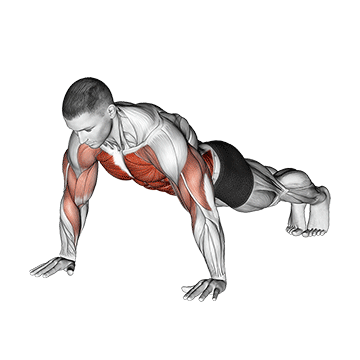
Begin by getting into a high plank position. Your hands should be directly under your shoulders and your feet hip-width apart. Keep your body in a straight line from your head to your heels. This is your starting position.
Engage your core and lift your right hand off the ground to tap your left shoulder. Be careful not to shift or rotate your hips. Your body should remain as still as possible, with only your arm moving.
Place your right hand back on the ground and repeat the movement with your left hand tapping your right shoulder. This completes one rep.
Continue alternating sides for the desired number of reps or time duration. Remember to keep your core engaged and your body still throughout the exercise.
This exercise can be modified to be easier by performing it on your knees instead of your toes. To make it more challenging, try increasing the speed of your shoulder taps or adding a push-up between each tap.
seated side crunch (wall)
_Waist_360.gif)
1. Start by finding a spot near a wall where you can sit comfortably with your back against the wall. Ensure you have enough space to move your arms and legs freely.
2. Sit down with your back against the wall. Your legs should be bent at the knees and your feet flat on the floor.
3. Place your hands behind your head, elbows pointing outwards. This is your starting position.
4. Now, exhale and slowly crunch your upper body to the right side. Try to bring your right elbow towards your right hip. Make sure to keep your back against the wall and your movements controlled.
5. Hold this position for a second, feeling the contraction in your abs.
6. Inhale and slowly return to the starting position.
7. Repeat the same movement on the left side, bringing your left elbow towards your left hip.
8. That's one rep. Aim to complete 10-15 reps for 3-4 sets.
Remember to keep your movements slow and controlled, focusing on the contraction of your abs. Avoid using your neck or shoulders to pull yourself up; the movement should come from your abs.
seated leg raise
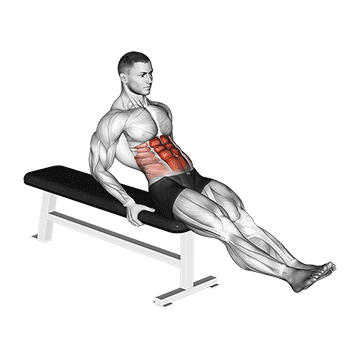
1. Start by sitting on the edge of a sturdy chair or bench. Place your hands on either side of your hips, gripping the edge of the seat for support.
2. Keep your back straight, chest up, and your abdominal muscles engaged. Your legs should be extended out in front of you, feet hovering above the floor.
3. Slowly raise your legs, keeping them straight, until they are parallel with the floor. Ensure your abs are doing the work, not your legs.
4. Hold this position for a few seconds, then slowly lower your legs back down without letting your feet touch the floor.
5. Repeat this movement for your desired number of repetitions.
Remember to keep your movements controlled and your core engaged throughout the exercise. This will ensure you are effectively targeting your abs. If you find this exercise too challenging, you can modify it by bending your knees and raising and lowering your legs that way.
russian twist
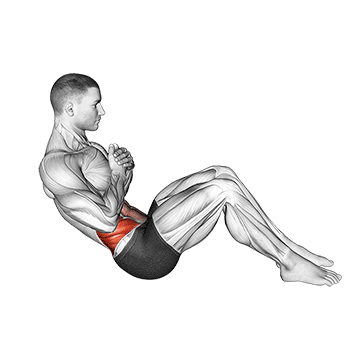
To perform the Russian Twist, start by sitting on the ground with your knees bent, pull your abs to your spine, and lean back a few inches while keeping your back straight. This is your starting position.
Next, extend your arms in front of you with your hands one on top of the other. Breathe out and slowly twist your torso to the right side until your arms are parallel with the floor. Keep your legs and hips as still as possible, and do not arch or round your back.
Pause for a moment, then inhale and return to the starting position. Exhale again, and this time, twist your torso and your arms to the left side. That completes one rep.
Remember to keep your abs engaged and your back straight throughout the exercise. Repeat for the desired number of reps.
This exercise can be done using just your body weight. However, for a more advanced version, you can hold a dumbbell, medicine ball, or kettlebell in your hands as you twist.
reverse plank with leg lift
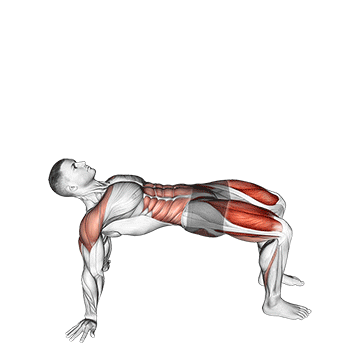
1. Start by sitting on the floor with your legs extended in front of you. Place your palms, fingers spread wide, on the floor slightly behind and outside your hips.
2. Press into your palms and lift your body, hips, and torso towards the ceiling. Look up to the ceiling, point your toes, and keep your arms and legs straight. Your body should be in a reverse plank position, making a straight line from your head to your heels.
3. From this position, slowly lift your right leg as high as you can without bending your knee. Keep your core engaged and maintain the reverse plank position.
4. Lower your right leg back to the starting position and repeat the same movement with your left leg.
5. This completes one rep. Aim for 10-15 reps, or as many as you can do with good form. Remember to keep your hips lifted throughout the exercise and avoid letting your lower back sag.
6. For beginners, you may start by keeping your knees slightly bent or perform the exercise without the leg lift. As you get stronger, you can progress to the full version of the exercise.
reverse crunch
1. Start by lying flat on your back on a comfortable, flat surface. Ensure your legs are fully extended and your arms are at your sides, palms down.
2. Bring your arms in so that your hands are resting beside your hips. This will help you maintain balance throughout the exercise.
3. Bend your knees and lift your legs so that your thighs are perpendicular to the floor and your calves are parallel to the floor. This is your starting position.
4. Engage your abs and pull your knees towards your chest, lifting your hips off the floor in a smooth, controlled motion.
5. Pause for a moment at the top of the movement, then slowly lower your legs back to the starting position.
6. Repeat this movement for your desired number of repetitions.
Remember to keep your movements controlled and steady, and to keep your abs engaged throughout the exercise. Avoid using momentum to lift your hips, and instead focus on using your abdominal muscles.
quarter sit-up
1. Start by lying flat on your back on a comfortable, flat surface. Bend your knees and plant your feet firmly on the ground. Your feet should be hip-width apart.
2. Place your hands behind your head, or cross them over your chest. Ensure your elbows are out to the sides and not locked.
3. Engage your abdominal muscles by drawing your belly button in towards your spine. This is your starting position.
4. Now, lift your head and shoulders off the ground in a controlled motion, while keeping your lower back pressed to the floor. This is a quarter sit-up. You should feel your abs working.
5. Hold this position for a second, then slowly lower your head and shoulders back down to the starting position.
6. Repeat this movement for your desired number of repetitions. Remember to breathe out as you lift your body and breathe in as you lower it back down.
7. Ensure to keep your movements slow and controlled, focusing on the quality of the movement rather than the quantity.
8. Avoid pulling on your neck or leading with your head, as this can cause strain. Your abs should be doing the work.
Remember, it's important to warm up before starting any exercise routine and cool down afterwards. Always consult with a healthcare provider before starting any new exercise regimen.
push-up to side plank
Begin in a high plank position, with your hands directly under your shoulders and your feet hip-width apart. Keep your body in a straight line from your head to your heels. This is your starting position.
Lower your body towards the floor by bending your elbows, while keeping your core tight and maintaining the straight line of your body. Push your body up returning to the high plank position.
Now, shift your weight onto your left hand and rotate your body to the right side, lifting your right hand towards the ceiling. Your body should be in a T shape, with your right foot stacked on top of your left. This is the side plank position.
Hold this position for a few seconds, then return to the high plank position.
Repeat the push-up, this time shifting your weight onto your right hand and rotating your body to the left side for the side plank.
Continue alternating sides for each rep. Remember to keep your core engaged throughout the exercise to target your abs effectively.
No equipment is needed for this exercise as you'll be using your own body weight for resistance.
prisoner half sit-up (male)
_360.gif)
1. Start by sitting on the floor with your knees bent and feet flat on the ground.
2. Interlock your fingers and place them behind your head, as if you were a prisoner. This is your starting position.
3. Engage your abs and lean back until your back is at a 45-degree angle with the floor. Ensure your back is straight and your abs are contracted.
4. Hold this position for a moment, then slowly lift your upper body towards your knees. Remember to keep your hands behind your head and your elbows wide.
5. Pause when your chest is just a few inches away from your knees, then slowly lower yourself back to the starting position.
6. Repeat this movement for your desired number of repetitions.
Remember to keep your movements slow and controlled, focusing on the contraction of your abs. Avoid pulling on your neck with your hands, as this can lead to strain. Your hands are simply there to support the weight of your head.
power point plank
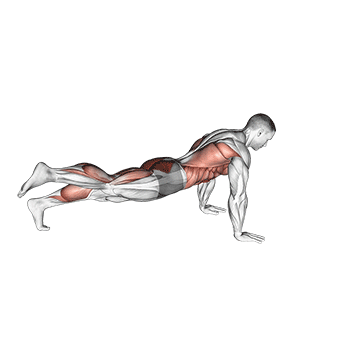
1. Start by positioning yourself on the floor as if you were about to do a push-up. Your hands should be directly under your shoulders and your body should form a straight line from your head to your heels. This is the starting position for the power point plank.
2. Now, lift your right hand off the floor and extend it straight out in front of you. At the same time, lift your left foot off the floor and extend it straight out behind you. Your body should still form a straight line, but now you're balancing on your left hand and right foot.
3. Hold this position for a few seconds, engaging your abs to keep your body stable.
4. Slowly return your right hand and left foot to the floor, then repeat the movement with your left hand and right foot.
5. Continue alternating sides for the desired number of reps or time.
Remember to keep your body straight and your abs engaged throughout the exercise. Avoid letting your hips sag or your back arch. If you find the exercise too challenging, you can modify it by keeping your toes on the floor and only extending your arms.
potty squat
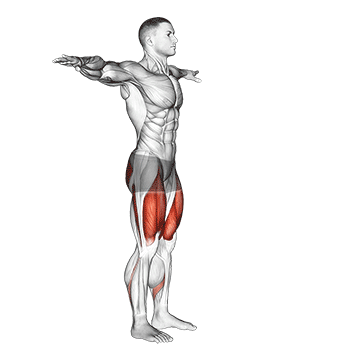
To perform the Potty Squat, start by standing tall with your feet hip-width apart. Your toes should be pointing forward or slightly outwards. This is your starting position.
Engage your abs by pulling your belly button in towards your spine. This will help to protect your lower back during the exercise.
Begin the exercise by bending your knees and pushing your hips back as if you were going to sit on a chair. Keep your chest up and your back straight. Lower yourself until your thighs are parallel to the floor. Make sure your knees are in line with your toes and do not extend past them.
Pause for a moment at the bottom of the squat, maintaining the tension in your abs. Then, push through your heels to stand back up to the starting position.
Remember to keep your abs engaged throughout the entire exercise. This will not only work your abs but also help to maintain proper form.
Repeat this exercise for the desired number of reps. No equipment is needed for this exercise as it uses your own body weight for resistance.
Remember to breathe during this exercise. Inhale as you lower into the squat and exhale as you push back up to standing.
The Potty Squat is a great exercise for targeting your abs and also works your glutes, quads, and hamstrings.
posterior step to overhead reach
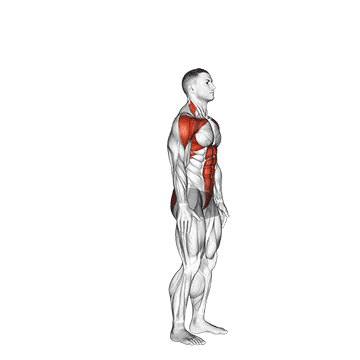
1. Stand tall with your feet hip-width apart. This is your starting position.
2. Take a step back with your right foot, bending both knees to lower your body into a lunge position. Keep your front knee directly above your ankle and your back knee hovering just off the floor.
3. As you step back into the lunge, simultaneously reach both arms overhead, extending your body and engaging your abs.
4. Push through your front heel to return to the starting position, lowering your arms back to your sides.
5. Repeat the movement, this time stepping back with your left foot and reaching overhead.
6. Continue alternating sides for the desired number of reps or time duration. Remember to keep your core engaged and your back straight throughout the exercise.
7. For an added challenge, increase the speed of the movement, ensuring you maintain proper form. This will increase the cardio aspect of the exercise, as well as further engage your abs.
pelvic tilt
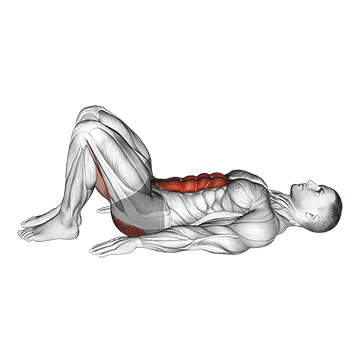
To perform the pelvic tilt exercise, start by lying flat on your back on a comfortable, flat surface. Bend your knees and keep your feet flat on the floor, hip-width apart. Your arms should be resting at your sides.
Take a deep breath and as you exhale, engage your abdominal muscles by pulling your belly button in towards your spine. At the same time, gently push your lower back into the floor. This is the pelvic tilt. You should feel your abs working and your lower back pressing into the floor.
Hold this position for a few seconds, continuing to breathe normally. Then, slowly release the tilt and return to the starting position. This completes one repetition.
Repeat this exercise for 10 to 15 repetitions, or as many as you can comfortably do. Remember to keep your abs engaged and your lower back pressed into the floor throughout the exercise.
The pelvic tilt is a great exercise for strengthening your abs and improving your core stability. It can be done without any equipment, making it a convenient exercise to incorporate into your routine.
oblique crunches floor
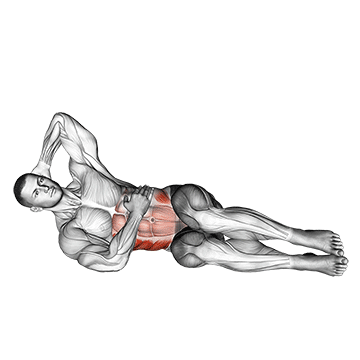
1. Start by lying flat on your back on the floor. Bend your knees and keep your feet flat on the ground.
2. Place your hands behind your head, but be careful not to pull on your neck.
3. Lift your right foot off the floor and cross your right ankle over your left knee. This is your starting position.
4. Now, exhale and lift your upper body off the floor, twisting your torso to the right as you do so. Try to bring your left elbow towards your right knee.
5. Hold this position for a moment, feeling the contraction in your abs.
6. Inhale and slowly lower your body back down to the starting position.
7. Repeat this movement for your desired number of reps.
8. Once you've completed your reps on one side, switch sides. Lift your left foot off the floor, cross your left ankle over your right knee, and repeat the crunches, this time twisting your torso to the left.
Remember to keep your movements slow and controlled, and focus on using your abs to lift and twist your body. Avoid using your hands to pull your head and neck up.
oblique crunch v. 2
To perform the Oblique Crunch V. 2, follow these steps:
1. Start by lying flat on your back on a comfortable, firm surface. Extend your legs and place your hands behind your head, elbows flared out to the sides.
2. Lift your legs off the ground, bending your knees at a 90-degree angle. This is your starting position.
3. Now, lift your upper body off the ground using your abdominal muscles, not your neck or shoulders. As you do this, twist your torso to the right, bringing your left elbow towards your right knee.
4. Lower your body back to the starting position, keeping your legs lifted off the ground.
5. Repeat the crunch, this time twisting your torso to the left and bringing your right elbow towards your left knee.
6. Continue alternating sides for each rep. Aim for 10-15 reps on each side, for a total of 20-30 reps.
Remember to keep your movements controlled and steady, focusing on the contraction of your abdominal muscles. Avoid pulling on your neck or using your arms to lift your body. Breathe out as you crunch up and twist, and breathe in as you lower back down.
negative crunch
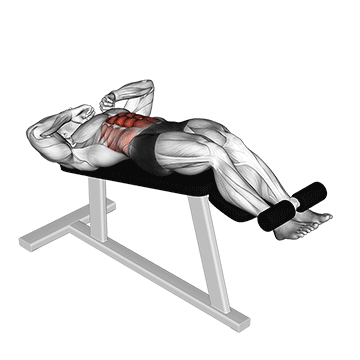
To perform a negative crunch, start by lying flat on your back on a comfortable, flat surface. Bend your knees and plant your feet firmly on the ground, hip-width apart. Place your hands behind your head, elbows flared out to the sides. This is your starting position.
Engage your core and lift your upper body off the ground, bringing your chest towards your knees. This should be a slow and controlled movement, not a jerky or rushed one. Ensure your lower back remains in contact with the ground throughout the movement to avoid straining it.
Once you've reached the peak of your crunch, where your shoulder blades are off the ground and your abs are fully contracted, hold this position for a second.
Now, instead of lowering your body back down quickly, perform the 'negative' part of the crunch. This involves slowly and deliberately lowering your body back to the starting position. The slower you go, the more you engage your abs.
Remember to breathe throughout the exercise. Inhale as you crunch up and exhale as you lower your body back down.
Repeat this exercise for your desired number of repetitions. Aim for 3 sets of 10-15 reps, or as many as you can do with good form.
Remember, the key to this exercise is the slow, controlled movement, particularly during the 'negative' phase. This is what really works your abs and helps to build strength and definition.
lying leg-hip raise
1. Start by lying flat on your back on a comfortable, flat surface. Extend your legs fully and place your arms at your sides, palms down.
2. Keep your legs together and straight. Engage your core muscles to stabilize your body.
3. Slowly raise your legs off the ground, keeping them straight. Continue to lift them until they are pointing straight up towards the ceiling.
4. Once your legs are vertical, push your hips off the ground using your abs. Try to lift your hips as high as possible, but ensure you're not straining your neck or back.
5. Hold this position for a moment, then slowly lower your hips back to the ground, followed by your legs.
6. Repeat this movement for your desired number of repetitions.
Remember to keep your movements slow and controlled, focusing on using your abs to lift your legs and hips. Avoid using momentum to swing your legs up, as this can lead to injury and won't effectively target your abs.
lying leg raise flat bench
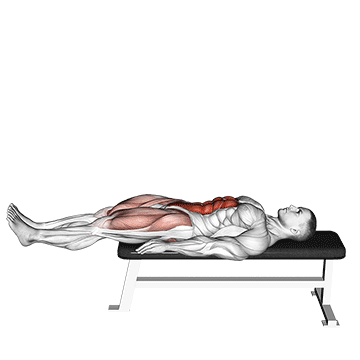
1. Start by positioning yourself on a flat bench. Lie down on your back and hold onto the bench above your head for support. Your legs should be extended out in front of you, hanging off the end of the bench.
2. Keep your legs together and straight. This will be your starting position.
3. Begin the exercise by raising your legs up until they are perpendicular to the floor while keeping them straight. Exhale as you perform this part of the motion and hold the contraction at the top for a second.
4. Slowly lower your legs back down to the starting position as you inhale. Ensure that you maintain control and do not let your legs drop. The movement should be performed by the abs and not by momentum or by swinging the legs.
5. Repeat for the recommended amount of repetitions.
Remember to keep your abs engaged throughout the exercise and avoid arching your back. If you find this exercise too challenging, you can bend your knees slightly.
lying elbow to knee
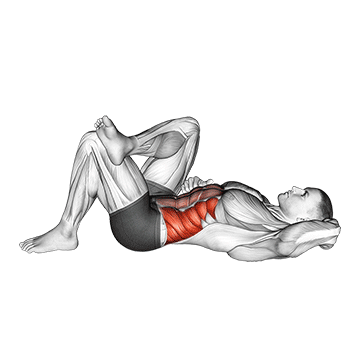
1. Start by lying flat on your back on a comfortable, firm surface. Extend your legs fully and place your hands behind your head, elbows flared out to the sides.
2. Engage your core muscles by pulling your belly button towards your spine. This will help protect your lower back during the exercise.
3. Lift your right leg off the ground, bending at the knee to bring it towards your chest. Simultaneously, lift your upper body off the ground, leading with your left elbow.
4. Try to touch your left elbow to your right knee. You should feel a strong contraction in your abs.
5. Slowly lower your upper body and right leg back to the starting position.
6. Repeat the movement with your left leg and right elbow. This completes one repetition.
7. Aim to complete 10-15 repetitions for 3-4 sets. Remember to keep your movements slow and controlled, focusing on the contraction of your abs.
8. As you get stronger, you can increase the number of repetitions or sets to challenge your abs further.
Remember, it's important to breathe during this exercise. Exhale as you lift your body and inhale as you return to the starting position.
lunge with twist
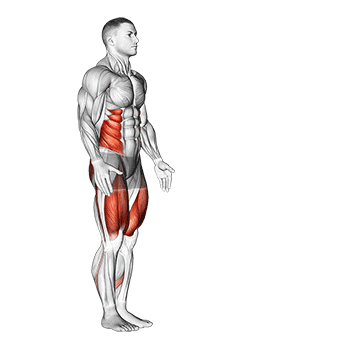
1. Stand straight with your feet hip-width apart. This is your starting position.
2. Take a step forward with your right foot, lowering your body into a lunge position. Your right knee should be bent at a 90-degree angle and your left knee should be hovering just above the ground.
3. As you're lunging, twist your upper body to the right. Make sure to engage your abs as you twist.
4. Twist back to the center, pushing off your right foot to return to the starting position.
5. Repeat the lunge and twist on the left side. This time, step forward with your left foot and twist your upper body to the left.
6. Continue to alternate sides for your desired number of reps or time duration. Remember to keep your abs engaged throughout the exercise to target the muscles effectively.
7. For beginners, you can start with 10 reps on each side. As you get stronger, you can increase the number of reps or the duration of the exercise.
8. Make sure to keep your movements controlled and your back straight throughout the exercise to avoid injury.
leg pull in flat bench
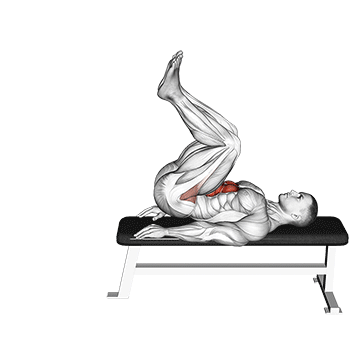
1. Start by finding a flat bench and sit on the edge. Ensure your legs are hanging off the side.
2. Place your hands behind you, gripping the edges of the bench for support. This will be your starting position.
3. Lean back slightly, keeping your back straight and engaging your abs.
4. Extend your legs out in front of you, keeping them together and slightly above the floor.
5. Pull your knees towards your chest while keeping your upper body stationary. As you do this, exhale and contract your abs.
6. Hold this position for a second, feeling the contraction in your abs.
7. Slowly extend your legs back to the starting position while inhaling.
8. Repeat this movement for the desired number of repetitions.
Remember to keep your movements controlled and steady, focusing on the contraction and extension of your abdominal muscles. Avoid using momentum to pull your knees in, as this can lead to injury and reduces the effectiveness of the exercise.
lean planche
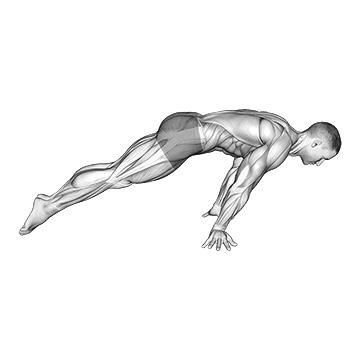
1. Start by finding a flat and open space where you can comfortably extend your body without any obstructions.
2. Stand straight with your feet shoulder-width apart.
3. Slowly bend forward at your waist and place your palms flat on the ground. Your hands should be slightly wider than shoulder-width apart.
4. Now, slowly walk your feet back until your body is in a straight line from your head to your heels. This is the starting position, similar to a push-up position.
5. Lean your body forward, shifting your weight onto your hands. Your shoulders should be directly above your hands.
6. As you lean forward, lift your feet off the ground and balance your body on your hands. Your body should be parallel to the ground.
7. Hold this position for a few seconds, engaging your abs and keeping your body straight.
8. Slowly lower your feet back to the ground and return to the starting position.
9. Repeat this exercise for the desired number of repetitions.
Remember to keep your core engaged throughout the exercise and maintain a straight body line from your head to your heels. If you find it difficult to lift both feet off the ground, start by lifting one foot at a time. As your strength and balance improve, you can progress to lifting both feet.
l-sit on floor
1. Start by sitting on the floor with your legs extended in front of you. Your palms should be flat on the floor beside your hips.
2. Press your hands into the floor and push your body up, lifting your hips and legs off the ground. Your body should be in a straight line from your head to your heels.
3. Hold this position for as long as you can, aiming for at least 10 seconds to start. Keep your abs engaged and your shoulders down and back.
4. Lower yourself back to the floor with control. This is one rep.
5. Repeat this exercise for as many reps as you can, aiming for at least 3 sets of 10 reps.
Remember to breathe throughout the exercise and keep your core engaged. If you find this exercise too challenging at first, you can modify it by keeping your knees bent and your feet on the floor. As you get stronger, you can start to lift one foot off the floor at a time, and then eventually both feet.
kneeling plank tap shoulder (male)
_Waist_360.gif)
1. Start by finding a comfortable spot on the floor. If you have a yoga mat, you can use it to cushion your knees.
2. Kneel down on the mat and lean forward to place your hands flat on the floor. Your hands should be shoulder-width apart and directly under your shoulders. This is your starting position.
3. Extend your legs behind you, one at a time, until you are in a plank position. Your body should form a straight line from your head to your heels.
4. Engage your abs by pulling your belly button in towards your spine. This will help to stabilize your core and protect your lower back.
5. Slowly lift your right hand off the floor and tap your left shoulder. Try to keep your hips as still as possible. The goal is to not let your body sway from side to side.
6. Place your right hand back on the floor and repeat the movement with your left hand tapping your right shoulder.
7. Continue alternating sides for the desired number of reps or time. Remember to keep your core engaged and your body in a straight line throughout the exercise.
8. To make the exercise easier, you can perform it from your knees instead of your toes. Just make sure to still keep your body in a straight line from your head to your knees.
9. Remember to breathe throughout the exercise. Inhale as you lower your hand back to the floor and exhale as you lift your hand to tap your shoulder.
10. After you've completed your set, slowly lower your knees to the floor and sit back on your heels to stretch out your abs and lower back.
Remember, the key to this exercise is control and stability, not speed. Take your time and focus on keeping your body as still as possible as you lift and lower your hands.
knee touch crunch
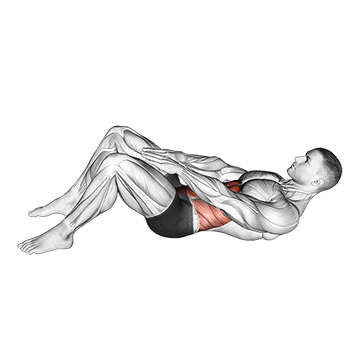
1. Start by lying flat on your back on a comfortable, firm surface. Extend your legs fully and place your hands behind your head. This is your starting position.
2. Engage your core and lift your upper body off the ground, bringing your chest towards your knees. At the same time, bend your knees and lift your legs off the ground, bringing them towards your chest.
3. Try to touch your knees with your elbows. If you can't touch your knees, just bring them as close as possible.
4. Hold this position for a second, making sure to keep your abs contracted.
5. Slowly lower your upper body and legs back to the starting position.
6. Repeat this movement for the desired number of repetitions.
Remember to breathe out as you crunch up and breathe in as you return to the starting position. Keep your movements slow and controlled to ensure you're using your muscles, not momentum, to complete the exercise.
janda sit-up
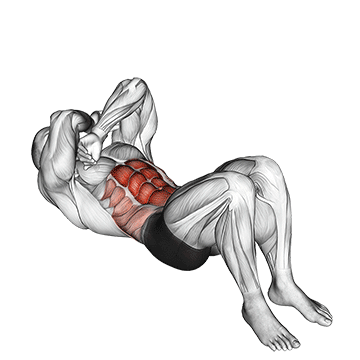
To perform the Janda Sit-Up, follow these steps:
1. Start by lying flat on your back on a comfortable surface, such as a yoga mat or carpeted floor. Bend your knees and keep your feet flat on the ground, hip-width apart.
2. Place your hands behind your head, but be careful not to pull on your neck. Your elbows should be out to the sides.
3. Engage your abdominal muscles by imagining pulling your belly button towards your spine. This will help protect your lower back during the exercise.
4. As you begin to sit up, push your feet into the ground but don't let them move. This is the key part of the Janda Sit-Up that targets your abs more intensely. You should feel your abs working harder as you try to lift your upper body while pushing your feet down.
5. Slowly lift your head, neck, and shoulders off the ground, curling up towards your knees. Keep your lower back on the ground.
6. Pause at the top of the sit-up, then slowly lower yourself back down to the starting position.
7. Repeat this movement for your desired number of repetitions.
Remember to breathe throughout the exercise, exhaling as you sit up and inhaling as you lower back down. Keep your movements slow and controlled to maximize the effectiveness of the exercise and to avoid injury.
jackknife sit-up
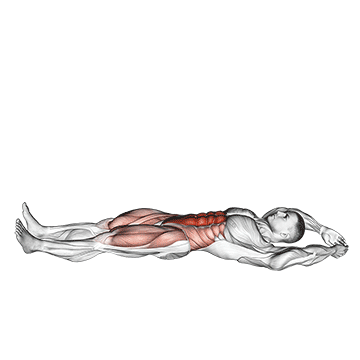
To perform the Jackknife sit-up, start by lying flat on your back on a comfortable, flat surface. Extend your arms straight back behind your head. This is your starting position.
Next, engage your abdominal muscles by pulling your belly button in towards your spine. This will help to protect your lower back throughout the exercise.
In one smooth motion, raise your legs and torso at the same time while keeping your legs straight. Try to touch your toes with your hands. Your body should form a V shape at the top of the movement.
Pause for a moment at the top of the movement, then slowly lower your body back down to the starting position. Be sure to keep your abs engaged and your back flat on the ground as you lower your body.
Repeat this movement for your desired number of repetitions. Remember to breathe throughout the exercise, exhaling as you lift your body and inhaling as you lower it back down.
This exercise can be modified to suit your fitness level. If you're a beginner, you may want to start by bending your knees as you lift your body, or by only lifting your upper body off the ground. As you get stronger, you can progress to the full Jackknife sit-up.
Remember, it's important to perform this exercise with proper form to avoid injury and get the most benefit. If you're unsure about your form, consider working with a personal trainer or fitness professional.
incline twisting sit-up
To perform the incline twisting sit-up, start by finding an incline bench. Sit on the bench and secure your feet under the pads at the top. Lean back until your body is in line with the bench. This is your starting position.
Engage your abs and lift your upper body towards your knees. As you sit up, twist your torso to the right, aiming to touch your left elbow to your right knee. Remember to exhale as you perform this movement.
Slowly lower yourself back to the starting position while inhaling. Repeat the movement, but this time twist your torso to the left, aiming to touch your right elbow to your left knee.
Continue alternating sides for each rep. Aim for 3 sets of 10-15 reps each, or as many as you can do with good form.
Remember to keep your movements controlled and your abs engaged throughout the exercise. Avoid pulling on your neck or using your arms to lift your body. The power should come from your abs.
This exercise is a great way to target your abs, especially the obliques, using just your body weight.
incline leg hip raise (leg straight)
_waist_360.gif)
1. Start by finding an incline bench or any inclined surface where you can comfortably lie down with your head at the top and feet at the bottom.
2. Lie down on the incline bench with your body facing upwards. Ensure your head is resting at the top of the bench and your legs are hanging off the bottom.
3. Place your hands under your glutes or hold onto the sides of the bench for support. This will be your starting position.
4. Keep your legs straight and together. Slowly raise your legs by flexing your hips while exhaling. Continue the upward movement until your hips are fully flexed and your legs are perpendicular to your torso.
5. Hold the contraction at the top for a second.
6. Slowly lower your legs back to the starting position while inhaling. Ensure your legs remain straight throughout the movement.
7. Repeat the movement for the desired number of repetitions.
Remember to keep your movements slow and controlled, focusing on the contraction of your abs. Avoid using momentum to raise your legs, as this can lead to injury and reduces the effectiveness of the exercise.
inchworm v. 2
To perform the Inchworm V. 2 exercise, start by standing tall with your feet hip-width apart. This is your starting position.
Next, bend forward at your hips and touch the floor with your hands. If you can't reach the floor, bend your knees slightly.
Once your hands are on the floor, walk them forward until your body is in a high plank position. Your hands should be directly under your shoulders and your body should form a straight line from your head to your heels.
Hold this position for a second, then start walking your feet towards your hands. Try to keep your legs as straight as possible.
Once your feet are as close to your hands as you can get them, walk your hands back out to the high plank position.
This completes one rep. Aim for 10-15 reps per set. Remember to keep your abs engaged throughout the exercise to maximize its effectiveness.
inchworm
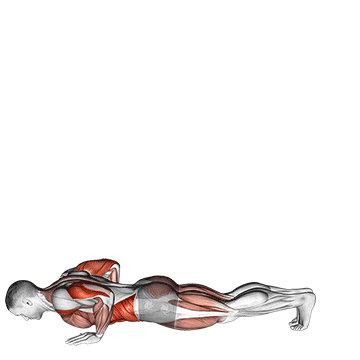
To perform the inchworm exercise, start by standing tall with your feet hip-width apart. This is your starting position.
Next, bend forward at your waist and touch the floor with your hands. If you can't reach the floor, bend your knees slightly.
Once your hands are flat on the floor, begin to walk them forward. Keep walking your hands out until you reach a high plank position. Your hands should be directly under your shoulders, and your body should form a straight line from your head to your heels.
Hold the plank position for a second, engaging your abs by pulling your belly button in towards your spine.
Then, start to walk your feet forward towards your hands. Try to keep your legs as straight as possible, but if you need to bend them slightly, that's okay.
Continue walking your feet forward until you're back in the starting position.
That's one rep. Aim for 10-15 reps, or as many as you can do with good form.
Remember to keep your abs engaged throughout the entire exercise, and try to keep your body in a straight line when you're in the plank position. This exercise not only targets your abs, but also works your arms, chest, and legs.
hip raise (bent knee)
_waist_360.gif)
To perform the hip raise (bent knee) exercise, follow these steps:
1. Start by lying flat on your back on a comfortable, flat surface. Extend your arms out to your sides at a 90-degree angle for stability.
2. Bend your knees and keep your feet flat on the ground. Your feet should be hip-width apart.
3. Pushing through your heels, lift your hips off the ground by contracting your abs. Your body should form a straight line from your shoulders to your knees.
4. Hold this position for a few seconds, ensuring your abs remain contracted and your body is in a straight line.
5. Slowly lower your hips back down to the starting position.
6. Repeat this movement for your desired number of repetitions.
Remember to keep your movements controlled and steady, and to breathe normally throughout the exercise. This exercise primarily targets your abs, but also works your glutes and hamstrings. No equipment is necessary for this exercise as it uses your own body weight for resistance.
hanging straight twisting leg hip raise
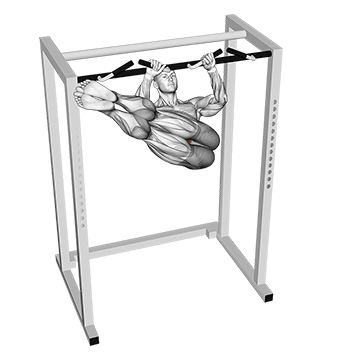
1. Start by finding a sturdy pull-up bar that can support your body weight. Make sure it's high enough so that your feet won't touch the ground when you hang from it.
2. Stand beneath the pull-up bar, reach up and grab it with an overhand grip. Your hands should be slightly wider than shoulder-width apart.
3. Allow your body to hang freely from the bar. Keep your legs straight and together. This is your starting position.
4. Begin the exercise by raising your legs up in front of you while keeping them straight. As you raise your legs, twist your hips to the right.
5. Continue to raise your legs until your body forms a 90-degree angle. Your legs should now be parallel to the ground.
6. Hold this position for a second, then slowly lower your legs back down to the starting position while untwisting your hips.
7. Repeat the movement, but this time twist your hips to the left as you raise your legs.
8. Continue alternating sides for each rep. Aim for 3 sets of 10-15 reps, or as many as you can do with good form.
Remember to keep your abs engaged throughout the exercise and avoid using momentum to raise your legs. This exercise should be performed in a slow and controlled manner to maximize its effectiveness.
hanging straight leg raise
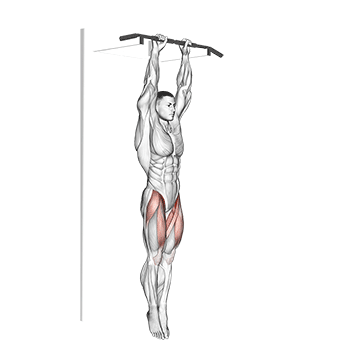
1. Start by finding a pull-up bar or any other sturdy overhead structure where you can hang freely without touching the ground.
2. Stand beneath the bar, reach up and grab it with an overhand grip. Your hands should be slightly wider than shoulder-width apart.
3. Allow your body to hang freely from the bar. Keep your arms and legs straight. This is your starting position.
4. Engage your core and slowly raise your legs up in front of you. Keep your legs straight as you lift them until they are parallel with the ground or as high as you can comfortably go.
5. Pause for a moment at the top of the movement, then slowly lower your legs back down to the starting position.
6. Repeat the movement for your desired number of repetitions.
Remember to keep your movements controlled and avoid swinging your body. The key to this exercise is to use your abs to lift your legs, not momentum. If you find this exercise too challenging, you can start with bent knee raises and gradually work your way up to straight leg raises as your strength improves.
hanging straight leg hip raise
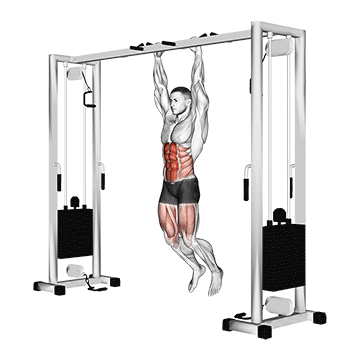
To perform the hanging straight leg hip raise, start by finding a sturdy pull-up bar. Stand beneath the bar, reach up and grasp it with both hands. Your grip should be slightly wider than shoulder-width apart, palms facing forward.
Once you have a firm grip, lift your body off the ground by bending your knees. Your body should be hanging freely from the bar, with your legs together and your feet off the ground. This is your starting position.
From here, keep your legs straight and together, then slowly raise them up in front of you. Try to keep your legs as straight as possible, and lift them until they are parallel with the ground. This movement should be controlled and deliberate, not a swing or a kick.
Once your legs are parallel with the ground, engage your abs and lift your hips towards your chest. This is the 'hip raise' part of the exercise. Try to keep your legs straight as you lift your hips.
Lower your hips and legs back down to the starting position in a controlled manner. This completes one repetition.
Remember to keep your core engaged throughout the exercise, and avoid swinging or using momentum to lift your legs. The movement should come from your abs and hips, not your legs or lower back.
Aim for 3 sets of 10-15 repetitions, or as many as you can do with good form. As your strength improves, you can increase the number of repetitions or sets.
This exercise is challenging but effective for targeting the abs. Remember to breathe throughout the exercise, exhaling as you lift your legs and inhaling as you lower them.
hanging pike
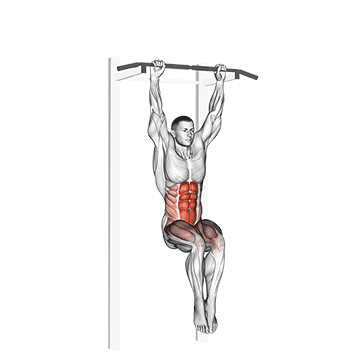
To perform the Hanging Pike exercise, follow these steps:
1. Start by finding a sturdy pull-up bar. Stand beneath it and reach up to grasp the bar with both hands. Your grip should be slightly wider than shoulder-width apart.
2. Jump up to hang from the bar, keeping your legs straight and together. This is your starting position.
3. Engage your abs and lift your legs up towards the bar. Try to keep your legs as straight as possible. Your body should form a 90-degree angle at the top of the movement.
4. Slowly lower your legs back down to the starting position. This should be done in a controlled manner to ensure your abs are engaged throughout the entire movement.
5. Repeat this movement for your desired number of repetitions.
Remember to keep your core engaged throughout the entire exercise and avoid swinging your body. This exercise can be challenging, so start with a small number of repetitions and gradually increase as your strength improves.
hanging oblique knee raise
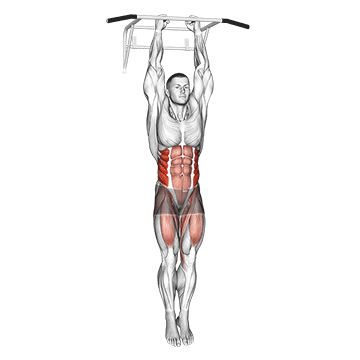
1. Start by finding a pull-up bar or any sturdy overhead bar that can support your body weight. Make sure it's high enough so your feet won't touch the ground when you hang.
2. Stand beneath the bar, jump up and grip it with both hands. Your palms should be facing forward and your hands should be shoulder-width apart. Allow your body to hang freely from the bar, keeping your legs straight.
3. Engage your core and lift your knees towards your chest. As you lift your knees, twist your hips to one side. This should be a controlled movement, not a swing.
4. Pause for a moment at the top of the movement, then slowly lower your legs back to the starting position.
5. Repeat the movement, this time twisting your hips to the opposite side. This completes one rep.
6. Aim to do 3 sets of 10-15 reps, or as many as you can manage with good form. Remember to keep your abs engaged throughout the exercise and avoid using momentum to lift your legs.
7. As you get stronger, you can increase the difficulty of the exercise by lifting your knees higher and twisting further.
Remember, the hanging oblique knee raise is a challenging exercise that requires a good amount of core strength and control. It's important to start slow and focus on maintaining good form.
hanging leg raise
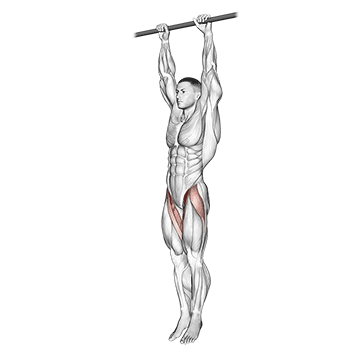
1. Start by finding a pull-up bar or any sturdy overhead bar that can support your body weight. Make sure it's high enough so your feet won't touch the ground when you hang.
2. Stand beneath the bar, reach up and grab it with an overhand grip (palms facing away from you). Your hands should be shoulder-width apart.
3. Allow your body to hang freely from the bar. Keep your legs straight and together, your arms fully extended, and your shoulders relaxed.
4. Engage your core muscles and keep your back straight. This is your starting position.
5. Slowly raise your legs up in front of you while keeping them straight. Try to lift them as high as you can, ideally until they're parallel with the ground or higher. Ensure that you're not swinging or using momentum to lift your legs; the movement should be controlled and initiated by your abs.
6. Hold the top position for a second, then slowly lower your legs back down to the starting position. Make sure to keep your abs engaged and your body still throughout the movement.
7. Repeat the exercise for your desired number of repetitions.
Remember to breathe during this exercise. Inhale as you lower your legs and exhale as you lift them. Also, keep your head and neck relaxed, and avoid pulling on the bar with your arms; your abs should be doing most of the work.
hanging leg hip raise
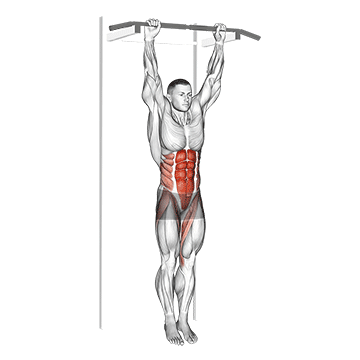
To perform the hanging leg hip raise, start by finding a pull-up bar or any sturdy overhead bar that can support your body weight.
1. Stand beneath the bar, reach up and grasp it with both hands. Your grip should be slightly wider than shoulder-width apart.
2. Once you have a firm grip, lift your body off the ground by bending your knees. Your body should be hanging freely from the bar, with your legs together and your arms fully extended.
3. Begin the exercise by slowly raising your legs up towards your chest. Keep your legs straight as you lift them.
4. As your legs reach the height of your waist, continue the movement by lifting your hips towards your chest. This is the 'hip raise' part of the exercise.
5. At the top of the movement, your body should form a 'U' shape, with your legs and torso almost parallel to the ground.
6. Hold this position for a moment, then slowly lower your hips and legs back down to the starting position.
7. Repeat the exercise for your desired number of repetitions.
Remember to keep your core engaged throughout the exercise to target your abs effectively. Also, avoid swinging or using momentum to lift your legs and hips. The movement should be controlled and deliberate for the best results.
half sit-up (male)
_360.gif)
1. Start by lying flat on your back on a comfortable, flat surface. Bend your knees and plant your feet firmly on the ground. Your feet should be hip-width apart.
2. Place your hands behind your head, or cross them over your chest. Ensure your elbows are out to the sides and not locked.
3. Engage your abdominal muscles by drawing your belly button towards your spine. This is your starting position.
4. Slowly lift your head, shoulders, and upper back off the ground. Exhale as you lift. Keep your core engaged and your lower back pressed into the floor.
5. Pause at the top of the movement for a moment. You should be in a position where your upper body is lifted halfway between the floor and your knees.
6. Slowly lower yourself back down to the starting position while inhaling.
7. Repeat this movement for your desired number of repetitions.
Remember to keep your movements slow and controlled, and avoid pulling on your neck with your hands. Your abs should be doing the work.
groin crunch
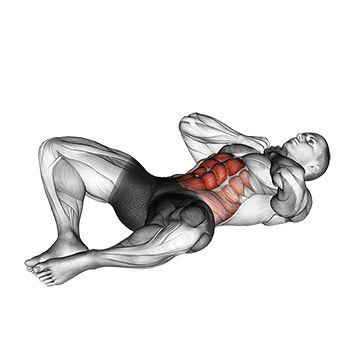
To perform the Groin Crunch, start by lying flat on your back on a comfortable, flat surface. Extend your legs straight out in front of you and place your hands on the floor by your sides for stability.
Next, lift both legs off the ground, keeping them straight. Spread your legs apart to form a 'V' shape. This is your starting position.
Now, engage your abs and lift your upper body off the ground, reaching your hands towards the center of the 'V'. Try to touch your toes if you can. This is the crunch part of the exercise.
Lower your upper body back down to the starting position, but keep your legs lifted. This completes one repetition.
Remember to keep your movements controlled and your abs engaged throughout the exercise. Avoid straining your neck or back.
Aim for 3 sets of 10-15 repetitions, or as many as you can manage with good form. This exercise not only targets your abs but also works your hip flexors and inner thighs.
Remember to breathe throughout the exercise, exhaling as you crunch up and inhaling as you lower back down.
As with any exercise, it's important to warm up before starting and cool down afterwards. If you feel any pain during the exercise, stop immediately and seek advice from a fitness professional.
gorilla chin
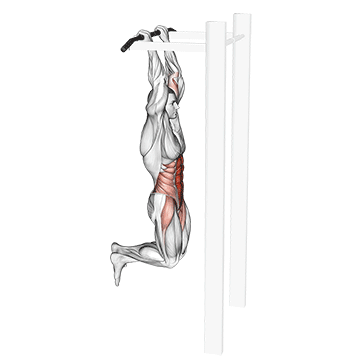
To perform the Gorilla Chin exercise, follow these steps:
1. Find a sturdy horizontal bar that can support your body weight. This could be a pull-up bar at a gym or a strong tree branch.
2. Stand directly under the bar and jump up to grab it with both hands. Your palms should be facing towards you in a supine grip, similar to a chin-up grip.
3. Once you have a firm grip, pull your body up until your chin is level with the bar. Keep your legs straight and together.
4. As you reach the top of the pull-up, bend your knees and lift them towards your chest. This is where the abdominal engagement comes in.
5. Hold this position for a moment, squeezing your abs tightly.
6. Lower your legs back down in a controlled manner, then slowly lower your body back to the starting position.
7. Repeat this process for as many reps as you can manage, aiming for 3 sets of 10 to 15 reps.
Remember to keep your movements slow and controlled to maximize muscle engagement and prevent injury. Breathe in as you pull yourself up and breathe out as you lower yourself down. This exercise not only targets your abs but also works your arms, shoulders, and back.
full planche
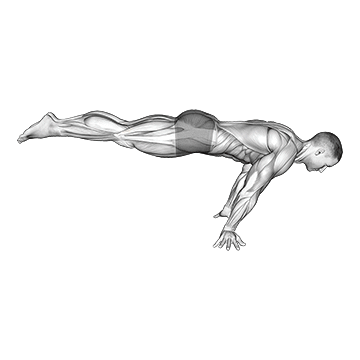
To perform the Full Planche exercise, follow these steps:
1. Start by warming up your body with some light cardio and stretching exercises to prepare your muscles for the workout.
2. Get into a push-up position on a flat surface. Your hands should be slightly wider than shoulder-width apart, and your feet should be together.
3. Lean forward and shift your body weight onto your hands. Your shoulders should be directly above your hands.
4. Engage your core and lift your feet off the ground. Your body should be parallel to the ground, and only your hands should be touching the floor.
5. Hold this position for as long as you can, keeping your body straight and your abs engaged. Remember to breathe normally throughout the exercise.
6. Lower your feet back to the ground to return to the starting position.
7. Repeat the exercise for the desired number of repetitions.
Remember, the Full Planche is an advanced exercise that requires a high level of strength and balance. If you're a beginner, you may want to start with easier variations and gradually work your way up to the Full Planche. Always listen to your body and stop if you feel any pain.
full maltese
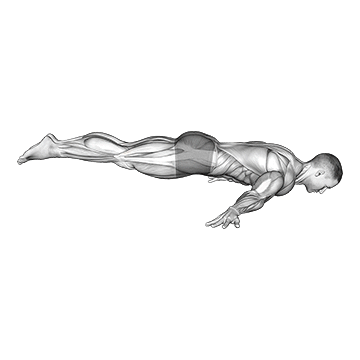
1. Start by finding a flat, comfortable surface where you can perform the exercise. This could be a yoga mat or a carpeted floor.
2. Lie down flat on your back with your legs extended and your arms by your sides. This is your starting position.
3. Slowly lift your legs and upper body off the ground at the same time, keeping your arms extended out to the sides. Your body should form a "V" shape.
4. Hold this position for a few seconds, engaging your abs. Make sure to keep your back straight and your core tight.
5. Slowly lower your body back down to the starting position.
6. Repeat this exercise for the desired number of repetitions.
Remember to breathe throughout the exercise, exhaling as you lift your body and inhaling as you lower it. Also, ensure to keep your movements slow and controlled to maximize the effectiveness of the exercise.
front plank with twist
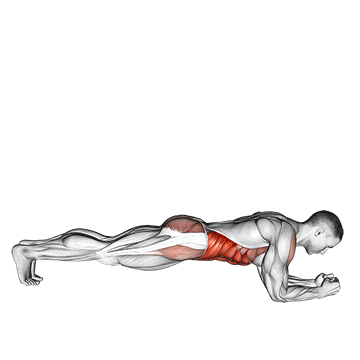
1. Start by positioning yourself on the floor as if you're about to do a push-up. Your hands should be directly under your shoulders.
2. Lower yourself onto your forearms, keeping your elbows directly under your shoulders. Your body should form a straight line from your head to your feet. This is your starting position, also known as the front plank position.
3. Now, twist your body to the right, lifting your right arm off the ground and extending it towards the ceiling. Your body should now be in a side plank position.
4. Hold this position for a few seconds, then slowly return to the front plank position.
5. Repeat the twist on the left side, lifting your left arm off the ground and extending it towards the ceiling.
6. Again, hold this position for a few seconds, then return to the front plank position.
7. This completes one repetition. Aim to do at least 10 repetitions for a full set.
Remember to keep your body straight and your core engaged throughout the exercise. Breathe normally and try to maintain a steady rhythm. This exercise not only targets your abs but also works your shoulders and obliques.
front lever
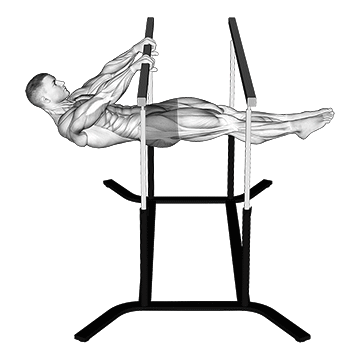
To perform the Front Lever exercise, follow these steps:
1. Find a sturdy horizontal bar that can support your body weight. This could be a pull-up bar or any similar equipment.
2. Stand under the bar and reach up to grab it with both hands. Your palms should be facing away from you in a pronated grip. Your hands should be shoulder-width apart.
3. Jump up and pull your body up to the bar, similar to a pull-up. Keep your body straight and horizontal to the ground.
4. Slowly lower your body until it's parallel to the ground, keeping your arms and legs straight. Your body should be in a straight line from your shoulders to your ankles, similar to a plank position but in the air.
5. Hold this position for as long as you can, aiming for at least a few seconds. Keep your core engaged and your body straight. This is the front lever position.
6. Slowly lower yourself back down to the starting position.
7. Repeat the exercise for the desired number of repetitions.
Remember to keep your body as straight as possible throughout the exercise. The front lever primarily targets your abs, but it also works your back, shoulders, and arms. It's a challenging exercise that requires a lot of strength and control, so don't be discouraged if you can't hold the position for very long at first. With practice, your strength and endurance will improve.
frog planche
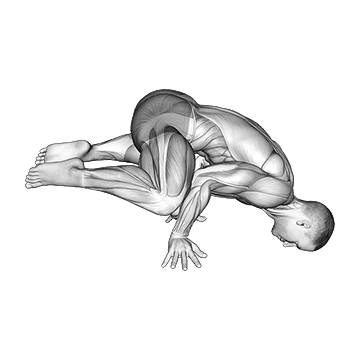
1. Start by getting into a squat position. Your feet should be wider than shoulder-width apart, and your toes should be pointed outwards.
2. Place your hands on the ground between your legs. Your fingers should be spread wide for better balance.
3. Lean forward and shift your weight onto your hands. Keep your elbows slightly bent.
4. Lift your feet off the ground by engaging your core muscles. Your knees should be bent and your thighs should be against your upper body.
5. Try to balance your body in this position. Your body should be parallel to the ground, and your abs should be engaged.
6. Hold this position for as long as you can, aiming for at least 10-30 seconds. Remember to breathe normally throughout the exercise.
7. Lower your feet back to the ground to return to the starting position.
8. Repeat the exercise for the desired number of repetitions.
Remember, this is a challenging exercise that requires strength, balance, and coordination. It's okay if you can't hold the position for very long at first. With practice, your strength and balance will improve.
frog crunch
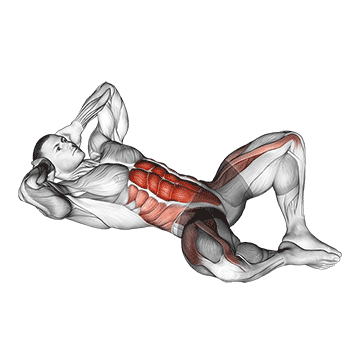
To perform the frog crunch, start by lying flat on your back on a comfortable, flat surface. Bend your knees and bring your feet together, allowing your knees to fall open to the sides, similar to a frog's legs. This is your starting position.
Place your hands behind your head, with your elbows pointing outwards. Engage your core and lift your head, shoulders, and upper back off the ground, performing a crunch. As you crunch up, simultaneously lift your hips off the ground, bringing your knees towards your elbows. Try to touch your elbows to your knees at the top of the crunch.
Slowly lower your upper and lower body back to the starting position, keeping your core engaged the entire time. This completes one repetition.
Ensure you maintain a controlled movement throughout the exercise, avoiding any jerky motions or using momentum to lift your body. The focus should be on using your abdominal muscles to perform the movement.
Aim for 3 sets of 10-15 repetitions, or as many as you can manage with good form. This exercise can be performed without any equipment and is a great way to target your abs.
flexion leg sit up (straight arm)
_waist_360.gif)
1. Start by lying flat on your back on a comfortable, flat surface. Extend your legs straight out and place your arms straight above your head.
2. Engage your core and lift your upper body off the ground while simultaneously raising your legs. Keep your arms straight and try to touch your toes with your fingertips.
3. Slowly lower your body back down to the starting position, keeping your arms and legs as straight as possible.
4. Repeat this movement for your desired number of repetitions.
5. Remember to breathe throughout the exercise. Inhale as you lower your body and exhale as you lift your body.
6. Keep your movements controlled and steady. Avoid using momentum to lift your body, instead focus on using your abdominal muscles.
7. For beginners, you may not be able to touch your toes. That's okay. Just lift your body as high as you can while keeping your arms and legs straight.
8. As you get stronger, you will be able to lift your body higher and touch your toes.
9. This exercise can be challenging, so start with a small number of repetitions and gradually increase as your strength improves.
10. Always listen to your body and stop if you feel any pain.
Remember, the key to this exercise is control and form. It's not about how many you can do, but how well you can do them.
flexion leg sit up (bent knee)
_waist_360.gif)
1. Start by lying flat on your back on a comfortable, flat surface. Your legs should be bent at the knees with your feet flat on the floor. Place your hands lightly behind your head or crossed over your chest.
2. Engage your abdominal muscles by drawing your belly button in towards your spine. This is your starting position.
3. Slowly lift your upper body towards your knees, keeping your feet flat on the floor. Your goal is to bring your chest as close to your knees as possible. Remember to use your abs to pull yourself up, not your neck or arms.
4. Hold this position for a moment, ensuring your abs are fully engaged.
5. Slowly lower your upper body back down to the starting position. This should be done in a controlled manner, resisting the pull of gravity.
6. Repeat this movement for your desired number of repetitions.
Remember to breathe throughout the exercise, exhaling as you lift your body up and inhaling as you lower it back down. Keep your movements slow and controlled to ensure your abs are doing the work and to prevent injury.
flag
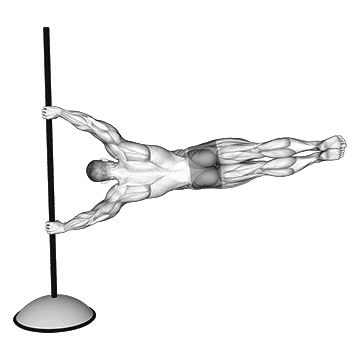
1. Start by lying flat on your back on a comfortable surface, such as a yoga mat or carpeted floor. Extend your legs straight out and place your arms at your sides.
2. Engage your core muscles by drawing your belly button in towards your spine. This is the starting position.
3. Slowly lift both your legs and upper body off the ground, keeping your legs straight and your arms extended at your sides. Your body should form a sort of 'flag' shape, with your legs as the flagpole and your upper body as the flag.
4. Hold this position for a few seconds, keeping your core muscles engaged and your body as straight as possible.
5. Slowly lower your legs and upper body back down to the starting position.
6. Repeat this exercise for a set number of repetitions or for a set amount of time.
Remember to breathe throughout the exercise, exhaling as you lift your body and inhaling as you lower it. Also, ensure to keep your movements slow and controlled to maximize the effectiveness of the exercise and to prevent injury.
elbow-to-knee
1. Stand up straight with your feet hip-width apart. This is your starting position.
2. Place your hands behind your head, with your elbows out to the sides. Make sure your chin is not tucked into your chest, but rather, keep a space between your chin and chest.
3. Lift your right knee up towards your chest while simultaneously twisting your torso to bring your left elbow towards your right knee. Try to touch your knee with your elbow.
4. Return to the starting position and repeat the movement on the opposite side. This time, lift your left knee towards your chest and twist your torso to bring your right elbow towards your left knee.
5. Continue alternating sides for the desired number of repetitions.
6. Remember to engage your abs throughout the exercise and keep your movements controlled. Avoid using momentum to swing your knee and elbow together.
7. Breathe out as you lift your knee and twist your torso, and breathe in as you return to the starting position.
This exercise can be performed for a set number of repetitions or for time. For example, you could aim to do 10-15 repetitions on each side, or perform the exercise for 30-60 seconds.
decline sit-up
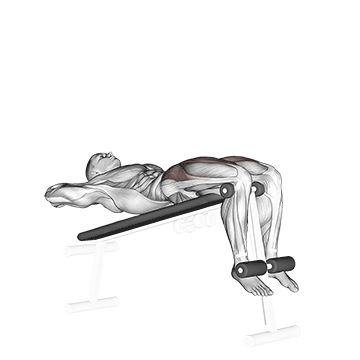
To perform a decline sit-up, start by securing your legs at the end of a decline bench. Your body should be fully extended with your hands either crossed on your chest or placed lightly behind your head. This will be your starting position.
Initiate the movement by flexing your hips and spine to raise your body upward. Keep your waist stationary and lift your upper torso until you're almost sitting straight up. Exhale as you perform this part of the motion and keep the abs engaged at all times.
Hold the contracted position for a brief moment, then slowly lower your body back down to the starting position while inhaling. Ensure that you maintain control of the movement and do not simply drop back down.
Repeat this movement for the desired number of repetitions. Remember to keep your abs engaged throughout the entire exercise to effectively target the abdominal muscles.
Note: Avoid pulling your neck with your hands or swinging your body to gain momentum as this can lead to injury. The movement should be slow and controlled, focusing on the contraction and extension of the abdominal muscles.
decline crunch
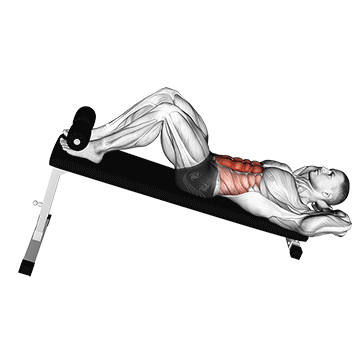
To perform the decline crunch, start by securing your legs at the end of a decline bench. Your body should be fully extended with your hands gently touching the sides of your head. This is your starting position.
Begin the exercise by flexing your abdominal muscles, curling your shoulders and upper back upwards towards your knees. Keep your lower back pressed against the bench at all times. Ensure your hands are not pulling your head but are just lightly touching it.
Hold the crunch at the top for a moment, focusing on the contraction in your abs. Then, slowly lower yourself back down to the starting position.
Remember to breathe out as you crunch up and breathe in as you lower back down.
Repeat this movement for your desired number of repetitions.
Ensure to keep the movement controlled, focusing on the use of your abs to move your body. Avoid using momentum to swing your body up and down.
This exercise can be made more challenging by holding a weight plate across your chest or by increasing the angle of the decline.
dead bug
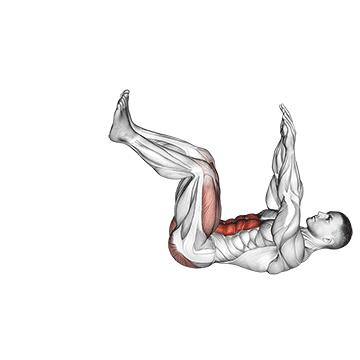
To perform the Dead Bug exercise, start by lying flat on your back on a comfortable, flat surface. Extend your arms straight up towards the ceiling, and raise your legs in a tabletop position, which means your knees are bent at a 90-degree angle above your hips.
Engage your core by pressing your lower back into the floor. This is your starting position. Slowly extend your right arm and left leg away from you, lowering them towards the floor but not letting them touch. Keep your arm straight and your leg bent at a 90-degree angle.
Pause for a moment, then slowly bring your arm and leg back to the starting position. Repeat the movement with your left arm and right leg. This is one repetition.
Ensure that your movements are slow and controlled, and that your lower back remains pressed into the floor throughout the exercise. If your back begins to arch, raise your leg higher or perform the exercise without the arm movement until you build up more strength.
Aim for 10-15 repetitions, or as many as you can manage with good form. This exercise targets your abs, but also works your lower back and hip flexors. No equipment is needed for this exercise, just your body weight.
curl-up
1. Start by lying flat on your back on a comfortable, flat surface. You can use a yoga mat or a soft carpet to avoid discomfort.
2. Bend your knees and plant your feet flat on the ground. Your feet should be hip-width apart.
3. Place your hands behind your head, lightly supporting it with your fingers. Be careful not to pull on your neck or head during the exercise.
4. Engage your abdominal muscles by drawing your belly button towards your spine. This is your starting position.
5. Slowly lift your head, shoulders, and upper back off the ground. Keep your core engaged and your lower back pressed into the floor.
6. Exhale as you lift your upper body, keeping your neck and shoulders relaxed. Your movement should come from your abs, not your neck.
7. Pause at the top of the movement, then slowly lower your upper body back down to the starting position while inhaling.
8. Repeat this movement for your desired number of repetitions.
Remember to keep your movements slow and controlled, focusing on the contraction of your abdominal muscles. Avoid using your hands to pull your head up, and keep your lower back pressed into the floor throughout the exercise.
crunch floor
1. Start by lying flat on your back on the floor. Bend your knees and plant your feet about hip-width apart. Your feet should be flat on the floor.
2. Place your hands behind your head, lightly supporting it with your fingers. Be careful not to pull on your neck.
3. Engage your abdominal muscles by drawing your belly button towards your spine. This is your starting position.
4. Exhale and slowly lift your upper body, keeping your head and neck relaxed. Your goal is to bring your chest towards your knees in a crunching motion.
5. Hold the crunch for a moment, feeling the contraction in your abs.
6. Inhale and slowly lower your upper body back down to the starting position.
7. Repeat this movement for your desired number of repetitions.
Remember to keep your movements slow and controlled, focusing on the quality of the crunch rather than the quantity. Your lower back should remain in contact with the floor throughout the exercise to avoid straining your back.
crunch (hands overhead)
_waist_360.gif)
Begin by lying flat on your back on a comfortable, firm surface. Extend your arms overhead, keeping them close to your ears. Your legs should be flat on the ground with your knees bent and feet flat on the floor.
Engage your abdominal muscles by drawing your belly button in towards your spine. This is your starting position.
Slowly lift your upper body, keeping your arms straight and next to your ears. Your goal is to lift your shoulder blades off the ground using your abdominal muscles, not your neck or arms.
Pause at the top of the movement for a moment, then slowly lower your upper body back down to the starting position.
Remember to keep your movements slow and controlled, focusing on using your abs to lift and lower your body. Avoid pulling on your neck or using your arms to generate momentum.
Repeat this movement for your desired number of repetitions.
This exercise can be modified to increase or decrease difficulty. To make it easier, you can place your hands on your thighs instead of extending them overhead. To make it more challenging, you can hold a light weight in your hands as you perform the crunch.
cross body crunch
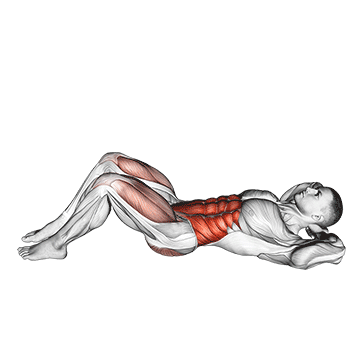
To perform the cross body crunch, start by lying flat on your back on a comfortable surface, such as a yoga mat. Extend your legs and spread them slightly wider than hip-width apart. Place your hands lightly behind your head, with your elbows flared out to the sides.
Next, lift your head, shoulders, and upper back off the ground. This is your starting position. Now, lift your right leg off the ground and bend your knee. At the same time, twist your upper body to the left, bringing your right elbow towards your left knee. Try to touch your knee with your elbow, but don't worry if you can't reach it. The goal is to feel a contraction in your abs.
Lower your leg and upper body back to the starting position. Repeat the movement on the other side, this time lifting your left leg and twisting your upper body to the right, aiming to touch your left knee with your right elbow.
Remember to exhale as you lift and twist, and inhale as you return to the starting position. Keep your movements controlled and avoid using momentum to lift your body. Your abs should be doing the work.
Aim for 10-15 reps on each side, or as many as you can manage with good form. This completes one set. Aim for 3 sets in total.
This exercise, the cross body crunch, is a great way to target your abs using just your body weight.
crab twist toe touch
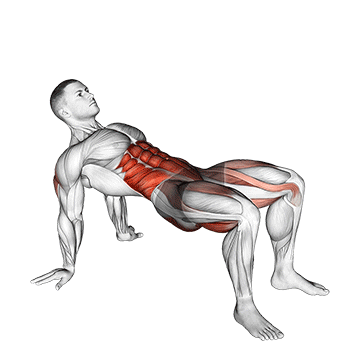
1. Start by sitting on the floor with your feet flat on the ground in front of you and your hands placed behind you, fingers pointing towards your feet. This is your starting position, similar to a crab walk position.
2. Lift your hips off the ground by pressing through your palms and heels. Your body should form a reverse tabletop position.
3. Now, lift your right hand off the floor and simultaneously raise your left foot off the floor.
4. Twist your torso to your left and try to touch your right hand to your left foot. Your left knee should be bent as you do this.
5. Return to the starting position and repeat the movement on the opposite side. This time, lift your left hand off the floor and your right foot, twisting your torso to the right to touch your left hand to your right foot.
6. Continue alternating sides for the desired number of reps or time.
Remember to keep your core engaged throughout the exercise to maximize the benefits for your abs. Also, try to keep your hips lifted as high as possible throughout the exercise. This exercise not only targets your abs but also works your glutes, shoulders, and legs.
cocoons
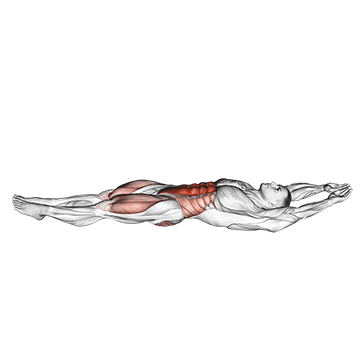
To perform the cocoons exercise, follow these steps:
1. Start by lying flat on your back on a comfortable, flat surface. Extend your arms and legs fully so your body forms a straight line.
2. Engage your core muscles. This is important as it helps to protect your lower back during the exercise and increases the effectiveness of the workout on your abs.
3. Simultaneously lift your legs and arms off the ground, bending at the waist and knees. Your body should form a 'V' shape.
4. As you lift your limbs, bring your knees and arms together, hugging your knees into your chest. Your body should now resemble a cocoon.
5. Hold this position for a few seconds, keeping your abs contracted.
6. Slowly lower your arms and legs back to the starting position, keeping them straight and not allowing them to touch the ground.
7. Repeat this movement for your desired number of repetitions.
Remember to breathe throughout the exercise, exhaling as you lift your limbs and inhale as you lower them. This exercise can be challenging, so start with a small number of repetitions and gradually increase as your strength improves.
captains chair straight leg raise
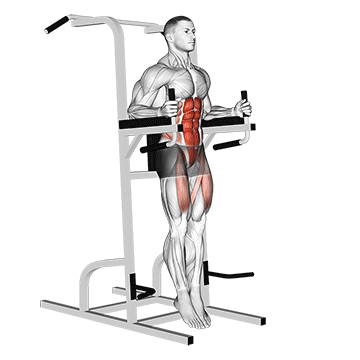
1. Start by locating the captain's chair equipment, which is a tall frame with padded armrests and a backrest.
2. Stand on the chair's platform and grip the handles to stabilize your upper body. Press your back against the pad and keep your shoulders relaxed.
3. Step off the platform so that your body weight is supported by your arms. Your legs should be hanging straight down.
4. Keep your legs together and straight, then slowly raise them in front of you until they are parallel with the floor. Ensure your abs are engaged and you're not using your momentum to lift your legs.
5. Hold this position for a moment, then slowly lower your legs back to the starting position.
6. Repeat this movement for your desired number of repetitions.
Remember to keep your movements controlled and steady, and avoid swinging your legs or using your lower back to lift them. This exercise should primarily engage your abs.
butt-ups
To perform the butt-ups exercise, start by finding a comfortable spot on the floor. You won't need any equipment for this exercise, just your body weight.
1. Lie down on your back with your legs extended straight out in front of you. Place your arms at your sides, palms down.
2. Bend your knees and lift your feet off the floor, bringing your knees directly over your hips. This is your starting position.
3. Engage your abs and lift your butt off the floor, pushing your feet towards the ceiling. Your body should form a straight line from your shoulders to your knees.
4. Pause for a moment at the top of the movement, then slowly lower your butt back down to the floor.
5. Repeat this movement for your desired number of reps.
Remember to keep your abs engaged throughout the entire exercise and avoid using momentum to lift your hips. Instead, focus on using your abs to control the movement. This exercise targets your abs but also works your glutes and lower back.
bridge - mountain climber (cross body)
1. Start by lying flat on your back on a comfortable, flat surface. Bend your knees and place your feet flat on the floor, hip-width apart. Your arms should be resting by your sides.
2. Push through your heels and lift your hips off the floor while keeping your back straight. This is your bridge position.
3. Now, bring your right knee towards your left elbow, while keeping your hips as high as possible. This is your cross-body mountain climber movement.
4. Return your right foot to the floor and repeat the movement with your left knee and right elbow.
5. Continue alternating sides for the desired number of repetitions or time duration.
6. Lower your hips back to the floor to complete one set.
7. Rest for a few seconds and repeat the set for the desired number of times.
Remember to keep your core engaged throughout the exercise and maintain a steady breathing pattern. This exercise not only targets your abs but also works your glutes and hamstrings.
bottoms-up
To perform the Bottoms-Up exercise, start by lying flat on your back on a comfortable, flat surface. Extend your legs fully and place your arms at your sides, palms down.
Engage your core and lift both legs straight up towards the ceiling, keeping them together and as straight as possible. This is your starting position.
From here, push your hips off the floor and towards the ceiling while you contract your abdominal muscles. Try to keep your legs straight as you lift your bottom off the floor.
Slowly lower your hips back down to the floor, keeping your legs extended upwards. This completes one repetition.
Ensure that your movements are controlled and steady. Avoid using momentum to lift your hips off the floor, instead focus on using your abdominal muscles.
Aim for 3 sets of 10-15 repetitions, or as many as you can manage with good form. Remember to breathe throughout the exercise, exhaling as you lift your hips and inhaling as you lower them.
This exercise can be modified to be easier by bending the knees, or more challenging by adding ankle weights. Always ensure you are using proper form to avoid injury and maximize results.
bodyweight incline side plank
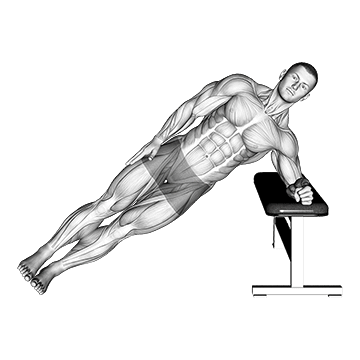
To perform the bodyweight incline side plank, follow these steps:
1. Find an elevated surface such as a bench, step, or sturdy box. The higher the surface, the more challenging the exercise will be.
2. Stand sideways to the elevated surface and place your right elbow on it. Your elbow should be directly under your shoulder to ensure proper alignment.
3. Extend your legs out straight, stacking your feet one on top of the other. Your body should form a straight line from your head to your heels.
4. Engage your core and lift your hips off the ground, coming into a side plank position. Your body should be diagonal, with your feet lower than your head.
5. Hold this position for a set amount of time, typically 30 seconds to a minute. Make sure to keep your hips lifted and your body in a straight line.
6. Slowly lower your hips back down to the ground to complete one rep.
7. Repeat on the other side by placing your left elbow on the elevated surface and stacking your feet with the left foot on top.
Remember to breathe throughout the exercise and keep your abs engaged. This exercise targets the abs, but also works the obliques and lower back. Adjust the height of the elevated surface to increase or decrease the difficulty of the exercise.
arms overhead full sit-up (male)
_360.gif)
1. Start by lying flat on your back on a comfortable, flat surface. Extend your legs fully and keep them together.
2. Extend your arms straight above your head, keeping them close to your ears. This is your starting position.
3. Engage your abdominal muscles by pulling your belly button in towards your spine.
4. Slowly lift your upper body off the floor, keeping your arms straight and next to your ears. Continue to lift your body until you're sitting completely upright.
5. At the top of the movement, your arms should be pointing straight ahead, parallel to the floor.
6. Hold this position for a moment, then slowly lower your body back down to the starting position.
7. Repeat this movement for your desired number of repetitions.
Remember to keep your movements controlled and steady, and to keep your abs engaged throughout the entire exercise. Avoid using your arms or neck to pull yourself up; the strength should come from your abs.
arm slingers hanging straight legs
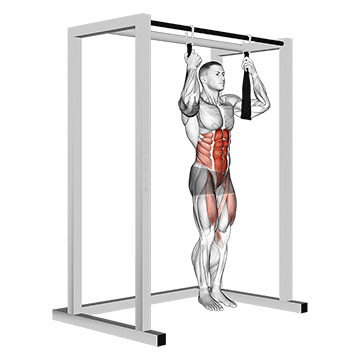
1. Stand upright with your feet shoulder-width apart. This is your starting position.
2. Extend your arms straight out to your sides, parallel to the ground. Your palms should be facing down.
3. Begin the exercise by swinging your arms in a circular motion, as if you were trying to fly. Keep your arms straight and your movements controlled.
4. While your arms are swinging, lift your legs straight up in front of you, keeping them together. Try to lift them as high as you can without bending your knees.
5. Lower your legs back down to the starting position while continuing to swing your arms.
6. Repeat this movement for the desired number of repetitions.
7. Remember to engage your abs throughout the exercise, pulling your belly button in towards your spine to ensure your abs are working.
8. Keep your back straight and avoid leaning back as you lift your legs.
9. For an added challenge, try to increase the speed of your arm swings and leg lifts without compromising your form.
10. This exercise can be performed in sets of 10-15 repetitions, with a short rest in between each set.
Remember, the key to this exercise is control and precision, not speed. It's more important to perform each repetition correctly than to do them quickly.
arm slingers hanging bent knee legs
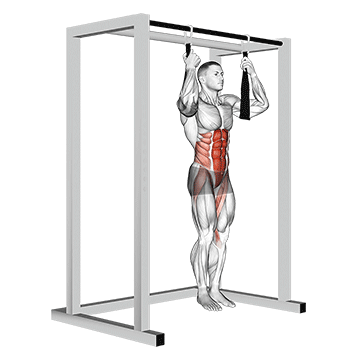
1. Begin by finding a sturdy bar that can support your body weight. This could be a pull-up bar at a gym or any other bar that is high enough for you to hang from without your feet touching the ground.
2. Stand beneath the bar and reach up to grasp it with both hands. Your palms should be facing forward and your hands should be slightly wider than shoulder-width apart.
3. Once you have a firm grip, bend your knees and lift your feet off the ground so that you are hanging from the bar. This is your starting position.
4. Keeping your upper body still, bend your knees and use your abs to lift your legs up towards your chest. Try to keep your legs together and your knees bent at a 90-degree angle.
5. Pause for a moment at the top of the movement, then slowly lower your legs back down to the starting position. Be sure to control the movement with your abs rather than letting gravity do the work.
6. Repeat this movement for the desired number of repetitions. Remember to keep your abs engaged throughout the entire exercise and avoid swinging your body.
7. For beginners, start with 10 repetitions and gradually increase as your strength improves. For more advanced exercisers, aim for 15-20 repetitions or more.
8. This exercise can be performed in sets of 2-3 with a rest period of 1-2 minutes in between each set.
Remember, the key to this exercise is control. It's not about how high you can lift your legs, but how well you can control the movement using your abs.
alternate heel touchers
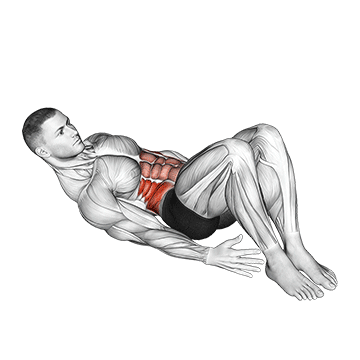
1. Start by lying flat on your back on a comfortable surface, preferably a yoga mat or carpeted floor. Extend your legs and place your arms by your side.
2. Bend your knees and plant your feet flat on the ground, hip-width apart. Your feet should be about a foot away from your buttocks.
3. Raise your head and shoulders slightly off the ground. This is your starting position.
4. Now, contract your abdominal muscles and twist your torso to the right, reaching your right hand towards your right heel. Try to touch your heel, but if you can't, go as far as your flexibility allows.
5. Return to the center and immediately twist your torso to the left, reaching your left hand towards your left heel.
6. Continue alternating sides for the desired number of repetitions. Each touch to the left and right counts as one rep.
7. Remember to keep your abdominal muscles engaged throughout the exercise and your movements controlled. Avoid straining your neck by keeping your gaze upwards and not pulling your head with your hands.
8. This exercise can be performed in sets of 10-15 repetitions, depending on your fitness level.
Remember, the goal is not speed, but rather engaging your abs and obliques through the twisting motion.
air bike
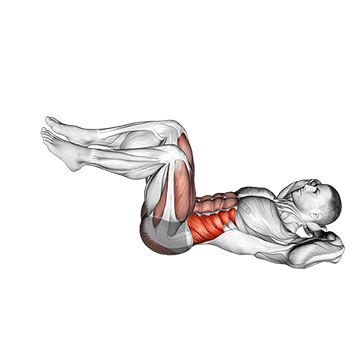
To perform the Air Bike exercise, start by lying flat on your back on a comfortable surface, such as a yoga mat. Your body should be fully extended with your arms by your sides.
Next, bring your hands up behind your head, with your elbows bent and pointing out to the sides. This is your starting position.
Now, lift your legs off the ground and bend your knees at a 90-degree angle. Your thighs should be perpendicular to your body, and your shins should be parallel to the ground.
From this position, engage your abs and lift your upper body off the ground, bringing your right elbow towards your left knee while simultaneously straightening your right leg out in front of you.
Then, quickly switch sides, bringing your left elbow towards your right knee while extending your left leg.
Continue alternating sides in a pedaling motion, as if you are riding a bicycle in the air.
Remember to keep your abs engaged throughout the exercise and avoid pulling on your neck with your hands. Your abs should be doing the work, not your neck or arms.
Perform this exercise for the desired number of repetitions or for a set amount of time, such as 30 seconds to a minute.
The Air Bike is a great exercise for targeting your abs using just your body weight. It's important to perform the movements in a controlled manner to maximize the effectiveness of the exercise.
45° side bend

To perform the 45° side bend exercise, start by standing up straight with your feet shoulder-width apart. Keep your back straight and your gaze forward. This is your starting position.
Next, place your hands on your hips or let them hang by your sides. Slowly bend your upper body to the right, aiming for a 45-degree angle. As you bend, ensure you're moving at the waist and not the hips. You should feel a stretch in your left side abdominal muscles.
Hold this position for a few seconds, then slowly return to the starting position. Now, repeat the movement on the left side, bending at the waist to achieve a 45-degree angle. You should feel a stretch in your right side abdominal muscles.
Remember to keep your movements slow and controlled, focusing on the stretch and contraction of your abdominal muscles. Avoid bending forward or backward, and keep your neck relaxed to avoid strain.
Repeat this exercise for your desired number of repetitions. For beginners, start with 10-15 repetitions on each side. As your strength and flexibility improve, you can increase the number of repetitions.
This exercise, when done correctly, targets your obliques and helps to strengthen and tone your abs. It's a great exercise that requires no equipment, just your body weight.
3/4 sit-up
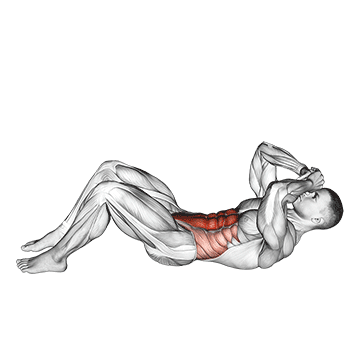
1. Start by lying flat on your back on a comfortable, flat surface. You can use a yoga mat or a soft carpet to avoid discomfort. Your legs should be bent at the knees with your feet flat on the floor.
2. Place your hands behind your head, but be careful not to pull on your neck. Alternatively, you can cross your arms over your chest. This is your starting position.
3. Begin the exercise by contracting your abdominal muscles. This should be done by pulling your belly button towards your spine.
4. Slowly lift your head, followed by your shoulder blades, off the floor while keeping your lower back on the ground. Remember to keep your neck in a neutral position. Your eyes should be focused on your knees.
5. Continue to rise until you're about three-quarters of the way up. You should be in a position where your upper body is off the ground but not fully upright.
6. Hold this position for a moment, feeling the contraction in your abs.
7. Slowly lower yourself back down to the starting position. This should be done in a controlled manner to maximize the effectiveness of the exercise.
8. Repeat this movement for your desired number of repetitions.
Remember to breathe in as you lower your body and breathe out as you lift your body. This exercise can be done in sets of 10-15 repetitions, depending on your fitness level.
No tags for this post.
